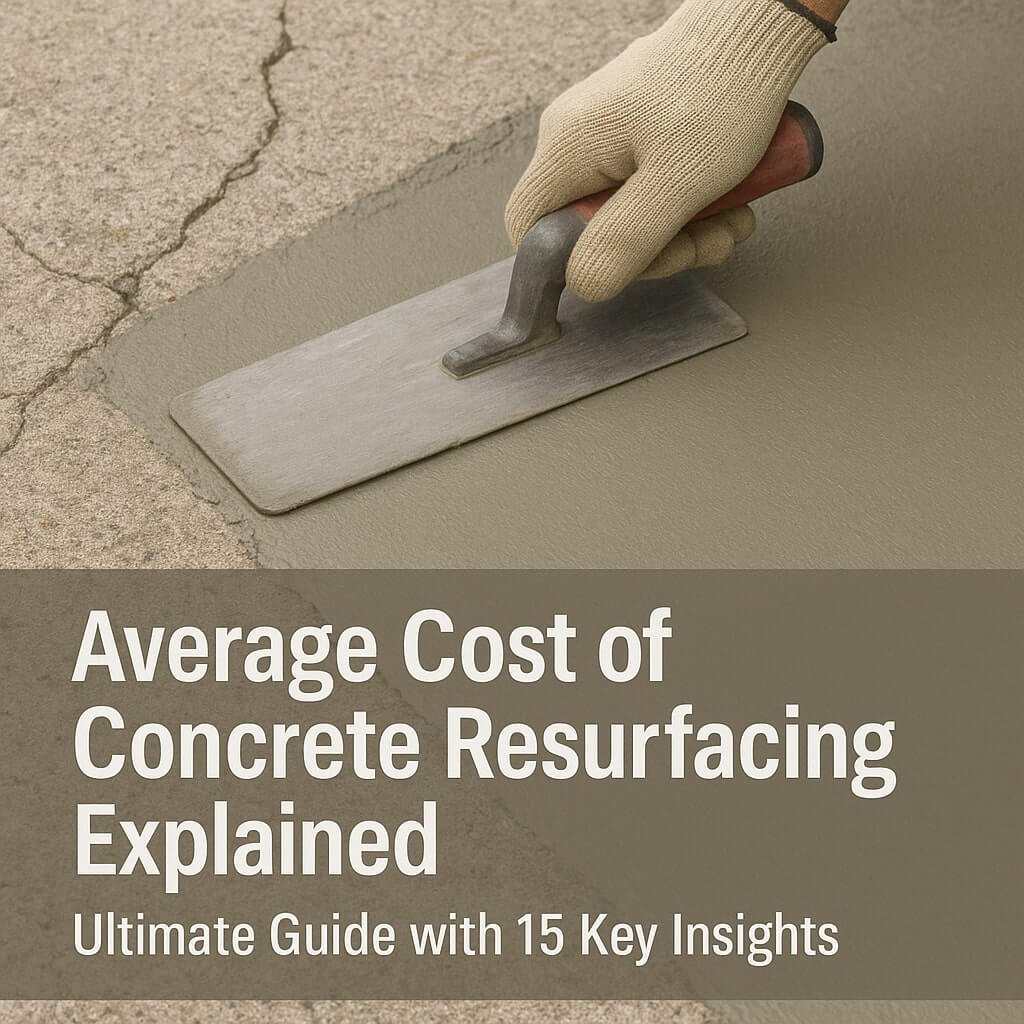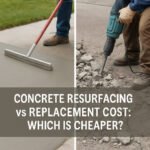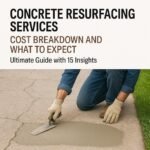Concrete resurfacing is an effective way to breathe new life into old, worn-out concrete surfaces without the need for costly replacement. Whether it’s a driveway, patio, or commercial flooring, resurfacing can enhance aesthetics and extend the lifespan of your concrete. But what exactly is the average cost of concrete resurfacing? This guide will walk you through everything you need to know about concrete resurfacing costs, factors influencing pricing, and how to get the best value for your investment.
What is Concrete Resurfacing?
Concrete resurfacing is the process of applying a new layer of specialised concrete overlay to an existing concrete surface. The goal is to improve the appearance, repair damage, and increase durability without the expense of tearing out and replacing the entire slab. Resurfacing materials vary from simple cement-based overlays to decorative options like stamped or stained concrete.
This technique is ideal for surfaces that are structurally sound but show cosmetic wear, such as cracks, discolouration, or minor surface erosion. By resurfacing, you create a fresh, clean surface that can last for many years with proper maintenance.
Why Concrete Resurfacing is a Smart Investment
Investing in concrete resurfacing offers several advantages:
- Cost-Effectiveness: It costs a fraction of full concrete replacement while delivering similar visual and functional benefits.
- Quick Turnaround: Resurfacing projects generally take a few days to complete, compared to weeks for replacement.
- Durability: Modern resurfacing materials provide added resistance to weather, wear, and stains.
- Aesthetic Appeal: Options like stamping and staining enable custom looks that mimic expensive materials like stone or brick.
- Sustainability: It reduces waste by reusing existing concrete, making it an environmentally friendly choice.
By choosing resurfacing, homeowners and business owners can enhance curb appeal, property value, and surface longevity without breaking the bank.
Factors Affecting the Cost of Concrete Resurfacing
Understanding what influences the cost of resurfacing helps you plan your budget realistically. Here are the main factors:
Material Types and Their Impact on Cost
The material you choose plays a significant role in pricing. Common resurfacing materials include:
- Basic Cement Overlays: Affordable and practical, these cost about $2 to $4 per square foot.
- Polymer-Modified Overlays: More durable with enhanced bonding, priced between $3 and $6 per square foot.
- Decorative Overlays: Stamped, stained, or colored concrete overlays can range from $5 to $12 per square foot, depending on complexity.
- Epoxy Coatings: Often used for industrial or garage floors, costing $4 to $7 per square foot.
Higher-end materials come with more design options and improved performance but at a higher cost.
Labour Costs and Regional Price Differences
Labor costs fluctuate based on geographic location, local demand, and contractor expertise. Urban areas or regions with higher living costs typically see increased labor charges. Labor usually accounts for 40-60% of the total project cost.
Surface Preparation and Repair Costs
If the concrete surface has significant cracks, spalling, or structural damage, repairs will be necessary before resurfacing. Surface preparation may involve cleaning, patching, grinding, or applying bonding agents, adding to the overall expense.
Average Cost Breakdown by Project Size
Project size dramatically impacts total cost since most pricing is based on square footage.
Small Projects (Under 500 sq. ft.)
Typical small areas like walkways or small patios may cost between $1,000 and $3,000 depending on materials and prep work.
Medium Projects (500-1500 sq. ft.)
Driveways or mid-sized patios generally range from $3,000 to $9,000. Medium projects often allow some economies of scale, reducing the per-square-foot cost slightly.
Large Projects (Over 1500 sq. ft.)
Commercial or large residential areas could run from $9,000 up to $20,000 or more, especially if decorative finishes are involved.
Concrete Resurfacing Process: Step-by-Step
Knowing the process helps set expectations:
- Inspection: Assess surface condition and identify repairs.
- Surface Preparation: Clean and repair cracks or holes.
- Priming/Bonding: Apply primer to help the overlay adhere.
- Mixing and Applying Overlay: Spread the resurfacing material evenly.
- Texturing/Design: Add stamping, staining, or other decorative finishes.
- Curing: Allow time for proper drying and hardening.
- Sealing: Apply sealant to protect the new surface.
DIY vs Professional Resurfacing: Cost and Quality Comparison
DIY can save money, but risks lower quality and durability. Professional contractors bring expertise, equipment, and guarantees, ensuring long-lasting results. DIY projects typically save 30-50% but require skill and time investment.
Common Mistakes to Avoid When Resurfacing Concrete
- Skipping surface prep
- Choosing the wrong materials
- Applying an overlay too thick or too thin
- Ignoring weather conditions during application
- Neglecting sealing and maintenance
Maintenance Tips to Prolong the Life of Resurfaced Concrete
- Clean regularly with mild detergents
- Avoid harsh chemicals and de-icers
- Reseal every 2-3 years
- Repair minor cracks promptly
Environmental Impact of Concrete Resurfacing
Resurfacing conserves resources by reusing existing slabs and reducing landfill waste. Choosing eco-friendly overlays with low VOCs and sustainable ingredients further minimises the environmental footprint.
Frequently Asked Questions (FAQs)
1. How long does concrete resurfacing last?
2. Can resurfacing cover large cracks?
3. How soon can I use the surface after resurfacing?
4. Is resurfacing suitable for outdoor surfaces?
5. What is the average cost per square foot?
6. Can I change the colour or texture during resurfacing?
Conclusion: Is Concrete Resurfacing Worth the Investment?
Concrete resurfacing provides an affordable, attractive, and durable solution to revitalize tired surfaces without full replacement costs. With multiple material and design options, it offers flexibility and value. If your concrete is structurally sound but needs cosmetic upgrading, resurfacing is definitely worth considering. For reliable results and longevity, hiring professional contractors is often the best route.









